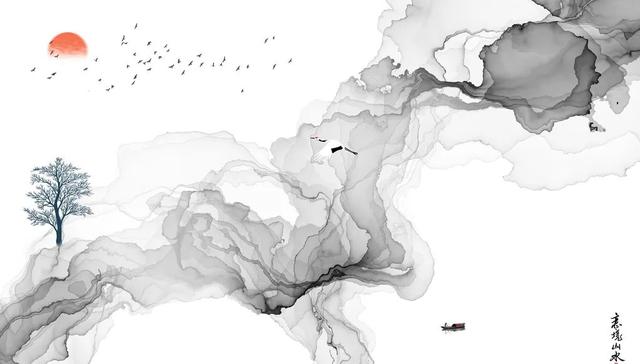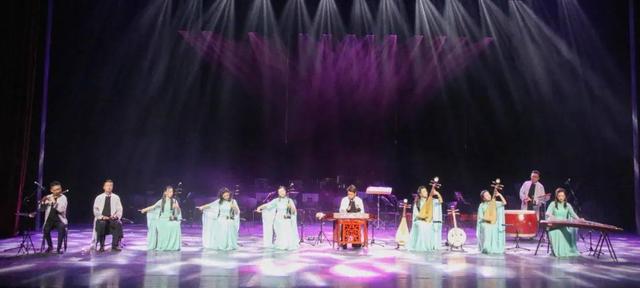"Impression of National Music: Germination" seeks the resonance between nature and life
Chimes and chimes in pre-Qin ritual music
Guqin and Ruan Xian in the Yaji Collection of Wei and Jin Dynasties
Pipa and Shakuhachi in the Tang court
Sanxian and Erhu in Ming and Qing Markets
...
Through the ages
Countless musical instruments record civilization with sound
Behind the National Music
It is the accumulation of thousands of years of Chinese civilization

The vegetation is growing, spring mountains are in sight, and a new spring is coming. Wandering in the spring light is like the rhythm of the heart.
On April 23, young performers from the Chinese Chamber Orchestra of Yinchuan Art Theater will play the "strongest sound" of folk music with traditional instruments such as Guzheng, Erhu, Pipa, Dixiao, Yangqin, and Zhongruan. Let’s listen to the inner yearning for beauty and seek the resonance of nature and life.
performance group

Yinchuan Art Theatre Chinese Chamber Orchestra is an ethnic chamber orchestra mainly based on traditional ethnic musical instruments. In recent years, through continuous creation, arrangement and adaptation of ethnic music works, it has expanded the integration of Western music and popular music, vigorously promoted the cultural and artistic exchanges of Chinese music, and made the More and more audiences have seen the youthful power of Chinese folk music.
two
program
1. Percussion
"The Twenty-Fourth Section: Awakening of Insects"
It was created by teacher Zhao Sizhi, a percussion teacher and a young percussionist of Sichuan Conservatory of Music. This piece is a percussion ensemble, mainly describing the natural scene of the twenty-four solar terms that startle spring thunder.
Played by: Yu Tianrui
2. Pipa ensemble
"Give me a rose"
Originally a Xinjiang folk song, it was later adapted into a pipa solo piece by Professor Wang Fandi, and won a gold medal for his performance at the 6th World Youth Festival held in the Soviet Union.
The melody is cheerful and smooth, with singing; the rhythm has obvious accent and has the characteristics of dance music. In the piece, the sound and rhythm of the tambourine in the Xinjiang band are imitated by the pipa panel, which is a very distinctive part of the whole piece.
Performers: Zhang Yuqi, Liu Xiayu, Liu Siqi, Yang Xiaojing
3. Percussion and Jinghu
"Deep Night"
"Deep Night" is a famous Peking Opera song. In Peking Opera "Drumming and Cursing Cao" and "Farewell My Concubine", it was used to match Mi Heng's drumming and Yu Ji's sword dancing.
The adaptor collects the lengths of each performance version and processes it. The structure of the music is expanded to have an introduction in the front, and then it is arranged according to the plate pattern of Adagio, Middle Plate, and Allegro. Among them are the solo of the big drum and the competition of drums and Jinghu, so that the essence of the original piece, the strong and soft music, is more fully expressed.
Performed by: Xu Jiabao, Yu Tianrui
4. Guzheng Solo
"Stable Storm"
The work was created in August 2015, and was named after the poem by Su Shi, a poet in the Northern Song Dynasty. This poem was written by Su Shi when he was demoted to Huangzhou in frustration. The author was moved by this poem and felt deeply, and used the meaning of the words to express the open-minded outlook on life in the face of hardships and fate in modern human society. In terms of music, the author has absorbed the music of Hunan and Hubei folk music, and while retaining the foundation of traditional folk music, he also applies some contemporary musical vocabulary expressions, with the intention of borrowing the feelings of the past to write the present.
Play: Xiang Wing
5. Erhu Concerto
"The Yellow River Love Song"
The music is based on northwestern tones and consists of three paragraphs: "Love Acacia", "Huanlian" and "Reminiscence". It describes the touching love story of the children of the Yellow River in the northwest, expresses the author's love for the magnificent Yellow River style and hometown, and yearning for a better life.
Performer: Wu Ying Accompaniment: MIDI
6. Pipa Concerto
"Late Autumn"
The Pipa Concerto "Late Autumn" was composed in late autumn of 2014 by young Chinese composer Li Bochan. "Young people don't know the taste of sorrow, but they fall in love with the floor. When they fall in love with the floor, they are forced to express their sorrow in order to create new words. Now they know the taste of sorrow, and they want to talk about it. This is the "Ugly Nuer, Shubo Mountain Road Middle Wall" written by Xin Qiji, a famous general, unrestrained poet, and famous writer in the Southern Song Dynasty.
The composer extracted the word "late autumn" from this poem as the title of the piece. Through the perfect combination of the pipa and the piano, he used musical language to depict a sad picture of all things being desolate, expressing "now that I know all the sorrows, But it's cool and it's a good autumn" state of mind, which also expresses the feeling of parting in the world from one side. The music is deep, poignant and beautiful, rich in connotation, immersive and memorable.
Performer: Zhang Yuqi Piano Accompaniment: Zhang Peng
7. Bamboo Flute Solo
"Le Chun"
"Le Chun" was created in 2014. The piece was originally a piece of flute and a large-scale national orchestra, and the whole piece was played on a bangdi in the key of F. The music is composed with the tune of the Northeast Yang Song, and the mood is warm and cheerful, expressing the joyous atmosphere of the working people in the north during major festivals.
Performer: Ji Xiang Piano Accompaniment: Zhou Ying
8. Erhu Concerto
"Westward Journey"
The inspiration for the creation of the second erhu concerto "Westward Journey" came from the large-scale Youku reality show "Lover Xing Season 3" composed by the author.
Zhang Xinyu, Liang Hong and his wife traveled 20,000 kilometers westward. Starting from Beijing, they overcame many obstacles and faced a potential crisis of war. With knowledge and courage, exploration and curiosity, we drove "Big White and Little White" through 16 countries in the Middle East, including Afghanistan, Iran, Iraq, Egypt, etc., let us re-understand this land shrouded in war, and how it is in this land. People living on the land suffer only from war and chaos, but human beings have love, hope, singing and dancing, and music. Go out with only love and courage.
Performer: Zhang Meng Accompaniment: Zhou Ying
9. Suona Solo
"Country Voice"
"Hometown Sound" is a suona solo piece composed by Mr. Wu Houyuan in the late 1970s. The author uses the elements of southern Fujian folk music to compose. It is cordial and touching, and it has realized the nostalgia for the hometown of wanderers who have lived overseas for a long time.
Performer: Di Lu Accompaniment: Zhang Peng
10. Percussion Ensemble
"Bull Fighting Tiger"
"Bull Fighting Tiger" is a dance that simulates the shape and habits of animals in Yuxian County, Shanxi Province. Its origin is a folk legend: in the Qianlong period of the Qing Dynasty, a painter named Du Kun entered the The mountain was chopping firewood, and witnessed a shepherd boy grazing cattle on the hillside and met a cheetah in the deep mountain. The cheetah was about to hurt the shepherd boy. The cow immediately resisted in order to protect the shepherd boy and fought fiercely with the cheetah, and finally defeated the cheetah and protected the moving story of the shepherd boy. Then he returned home and created the dance "Bull Fighting Tiger" with other folk artists. In order to facilitate the performance, they changed the cheetahs they saw into tigers and performed with gongs and drums. Although the dance shows the battle between animals, it expresses the ideological connotation of the working people that the evil does not oppress the righteous, and the weak are not afraid of the strong. "Bull Fighting Tiger" has also been completely preserved as a Han folk cultural heritage.
Today, the Chinese national percussion piece "Bull Fighting Tiger" that we often see on the stage is extracted from the dance soundtrack. Mr. Wang Guojie composed the original piece, which was later adapted by the Shanxi Provincial Drum Art Troupe. Performer: Li Weijing Yu Tianrui
11. National Chamber Music
"Mountain Fantasy"
The inspiration for the creation comes from "Fu Mountain" by the Tang Dynasty poet Linghu Chu. This piece has a three-part structure and uses a 6/8 rhythm. The first theme is developed from the bass to the treble by a lively and lively motive; the second theme is a long line of lyrical phrases. The works reflect the composer's exploration and thinking in combining musical style with audibility and technology in the creation of national chamber music.
Performance: Yinchuan Art Theatre Chamber Orchestra
12. National Chamber Music
"Dunhuang"
The work is a small instrumental ensemble composed by Jiang Ying, the composer-in-residence of the Central Chinese Orchestra. This piece incorporates the artistic elements of the Mogao Grottoes in Dunhuang, which not only reflects the rich expressive power of ethnic musical instruments, but also a breakthrough in the innovation of ethnic music.
Performance: Yinchuan Art Theatre Chamber Orchestra
13. Guzheng Ensemble
"Yellow River"
The Yellow River is the spiritual symbol of the Chinese nation, and the guzheng is the traditional musical instrument of the Chinese nation. The combination of the two not only shows the heroic spirit of the children of the Yellow River, but also shows the unique spirit and pride of the Chinese nation.
Playing: Xiang Yi, etc.
performance information
show time
April 23, 2022 (Saturday)
19:30
performance location
Yinchuan Theater · Small Theater
Show Tickets
30/60/90 yuan
traditional, enduring
classic, timeless
In the classic wandering of folk music
Let's resonate with the same frequency
 渝公网安备 50010702504639号
渝公网安备 50010702504639号